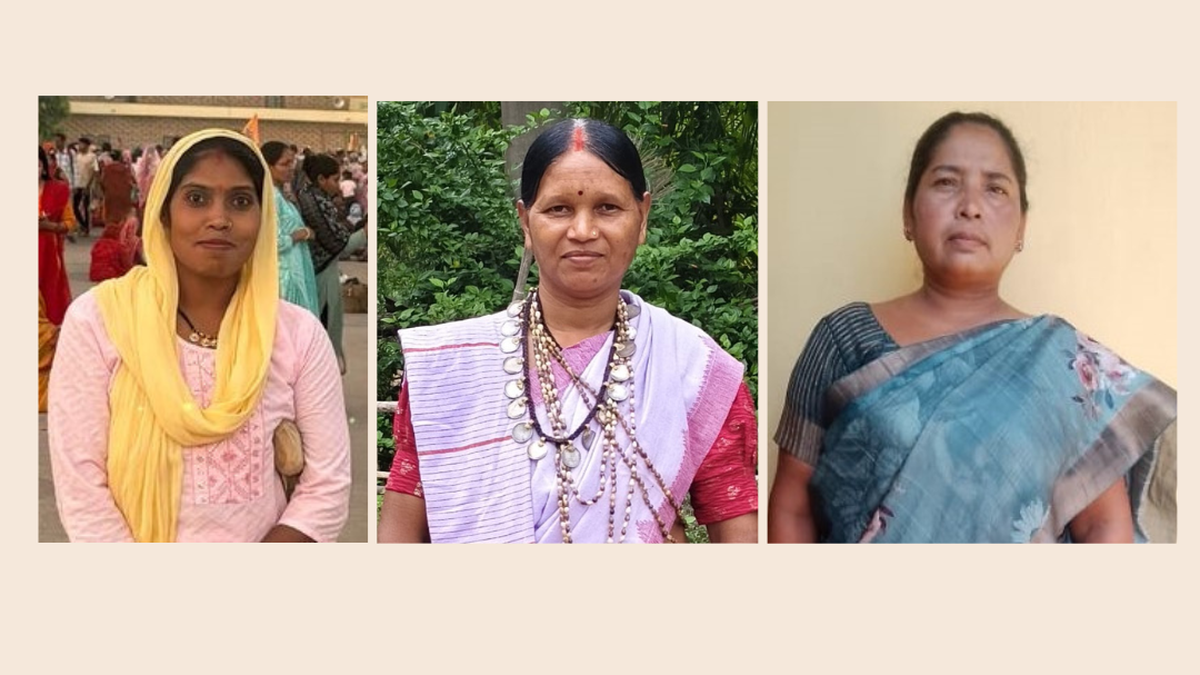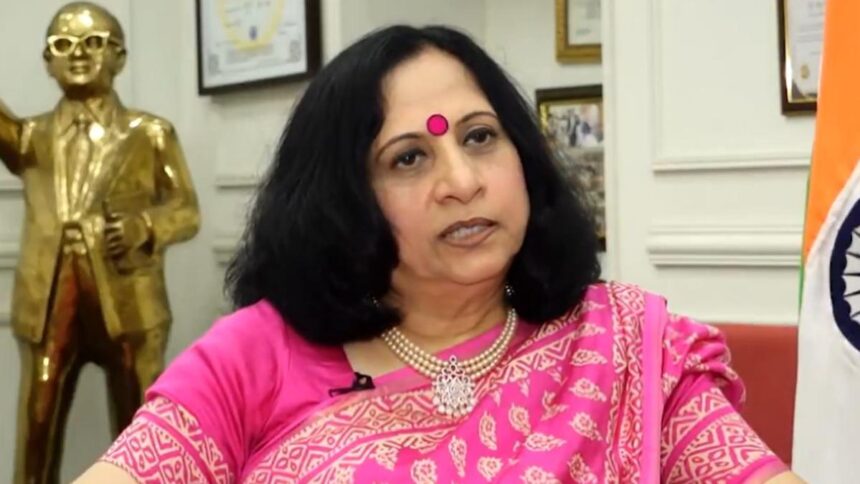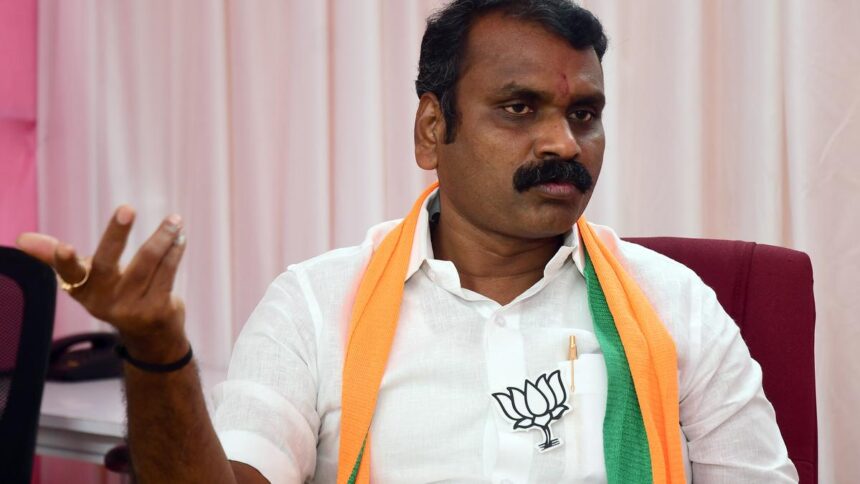For Vimala Nag, 38, improving the standard of living in her village Gumma in Chhattisgarh’s Chhindgarh tehsil was a stubborn dream. Growing up watching her parents work to improve local facilities, she was driven to bring about change. She had seen women’s concerns — from inactive self-help groups (SHGs) to the absence of toilets — ignored by village leaders. Nag realised that to bring about big changes, you need real power — like that of a sarpanch (village head). So, in 2015, she stepped out of the familiar world of farming, contested the panchayat elections and won, becoming the first woman in her village to hold the post.
In Jharkhand’s Garyajor panchayat, Pratima Kujur, 47, was a book-keeper for 10 SHGs. She often went beyond her role, helping people access government schemes and raising community concerns. Elected sarpanch in 2022, Kujur saw it as a chance to make the remote panchayat self-reliant. A member of one of Jharkhand’s largest tribes, Oraon, the position also gave her a platform to voice their concerns.


“Being a sarpanch is seen as a man’s job. I have a disability and use crutches, which made it easier for the men in my village to dismiss me. But it hasn’t stopped me from doing good work.”Sunita BhalaviSarpanch of Barchabuzurg village, Madhya Pradesh
In Madhya Pradesh’s Barchabuzurg village, Sunita Bhalavi ran for sarpanch in 2022 out of frustration. A scheduled caste member, she had seen her community repeatedly ignored by previous village heads, with essentials such as pensions delayed. Driven by the need for representation, she became the first sarpanch from a Scheduled Caste. “I have seen how caste bias works, and hope to make the village inclusive,” says 28-year-old Bhalavi, who has studied till class XII.
Nag, Kujur and Bhalavi are among the 1.4 million women elected to Panchayati Raj institutions in India, leading rural governance with bold visions for their villages’ future. However, they operate in a system that is not designed for them. Despite reservation, villages like Gumma are seeing a woman sarpanch for the first time in the 2020s.
These sarpanches have focused on improving infrastructure. In the last three years, Bhalavi has addressed issues of water scarcity and poor sanitation. A new water tank is nearing completion, and she has introduced the NADEP, an organic composting method, to tackle garbage disposal. In Garyajor, Kujur has built a vital connecting road and a supply system to bring clean water to a neglected area.


“I want to create local jobs so no one struggles for basic needs or is forced to migrate.”Pratima KujurSarpanch of Garyajor panchayat, Jharkhand
When didi understands
These women have also been stressing on financial independence, driven by their own experiences with economic instability. They have strengthened SHGs, reviving dormant groups and encouraging women to start micro-enterprises.
Nag has built toilets through government schemes and set up gothans — shelters for cattle that people can’t keep at home. Within it, she has created spaces for women to start small businesses making incense sticks and soaps. “Creating spaces where village women can work together has been my priority,” she says.
Bhalavi hopes more women will step into leadership roles. “Women understand household and community issues. Men aren’t as proactive, so having women in decision-making helps address often overlooked local issues,” she says.
During Nag’s tenure as sarpanch, women’s participation in the gram sabha and the Integrated Natural Resource Management (INRM) planning process has grown significantly. She is working to reduce maternal mortality in her village, where deaths after childbirth have become alarmingly common.


“Creating spaces where village women can work together has been my priority.”Vimala NagSarpanch of Gumma in Chhattisgarh
In Garyajor, identifying a teacher shortage, Kujur approached the local MLA to request for recruitment. Today, the village school has a better teacher-student ratio. She also started a weekly market, saving farmers the hardship of walking over 10 km to sell their produce. “I want to create local jobs so no one struggles for basic needs or is forced to migrate,” she says.
Shanta Bai, a Garyajor resident, says basic needs were ignored by past leaders. “But since Pratima didi became sarpanch, work on roads, drinking water, electricity, and gas connections has finally started,” she says, adding that Kujur’s SHG experience helps her understand and address women’s problems. “She holds special meetings with village women, and we are happy that didi is our sarpanch.”
Training women to lead
While constitutional rights and reservations have opened the door for more women to assume leadership roles in rural areas, women sarpanches continue to face challenges.
Empowering women leaders is not just about getting them elected, says Jitendra Pandit, Associate Director-Governance, Transform Rural India. “Women might feel that they are not performing well, but often it is a systemic problem rooted in patriarchy,” he says.
Nag says people often overlook her and seek advice from her husband, the gram sachiv (village secretary). “Men don’t give me the same importance as my husband,” she says. However, many women feel more comfortable sharing problems with a woman sarpanch.
“One of our surveys showed that nearly 95% of villagers would approach male leaders rather than a woman sarpanch,” says Pandit, emphasising the importance of training women leaders in agency, confidence, authority, and leadership, to navigate these challenges.
Bhalavi recalls how when she became sarpanch, men said she wouldn’t be able to do the work. “It was seen as a man’s job. I have a disability and use crutches, which made it easier for them to dismiss me. But it hasn’t stopped me from doing good work,” she says.
Not mere figureheads

Neena Gupta and Raghubir Yadav (left) in the webseries ‘Panchayat’.
Many villages face the issue of proxy leadership, wherein male family members act as the sarpanch after a woman is elected — as is famously portrayed in the web-series Panchayat, headlined by Neena Gupta.
Says Bhalavi, “One of our previous sarpanches was a mere figurehead. We elect women with hope, and when this happens, it affects all of us.”
Recognising proxy leadership as a deep-rooted issue, the Ministry of Panchayati Raj launched a digital campaign earlier this year with The Viral Fever (TVF), a media service, to produce videos addressing rural governance challenges. (Incidentally, TVF is the producer of Panchayat.) The government has called for “exemplary penalties” in proven proxy leadership cases and recommended setting up helplines for confidential complaints and whistle-blower rewards.
“Women do wonders as leaders, especially with issues like health, education, nutrition, sanitation, and addressing violence, so it’s important to make these positions accessible to them,” says Pandit of Transform Rural India. “Under women’s leadership, SHGs, which play a key role in women’s financial independence, thrive.”
For Nag, Kujur, and Bhalavi, being sarpanch is not just a position. It’s an opportunity to create real change in their villages. “It’s always been my dream to make my village a model one,” says Bhalavi.
The independent journalist specialises in gender, culture, and social justice.























